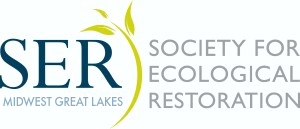SER-MWGL 2025 Fall Webinar
Fall Webinar Recording –
SER-MWGL Fall 2025 Webinar: Integrating Prairie Strips on Farm for Water Quality and Resilience
SER-MWGL 2025 Fall Webinar
Passcode: Yk+y7G@E
By Mr. Greg Olson & Dr. Heidi Peterson, Sand County Foundation
Date: Wednesday, September 17
Time: 12:00 pm – 1:00 pm CDT
Description:
Sand County Foundation’s efforts to advance the adoption of prairie strips began in 2017, with the implementation of six demonstration sites in Wisconsin to demonstrate how they function on varying soil types, topography, and management. We will present highlights of our research.
Abstract:
A prairie strip is a linear planting of native perennial forbs and grasses within or along the edge of a row crop field. Seed mixes include wildflower species that bloom in the spring, summer, and fall, providing habitat for pollinating insects across the growing season. The stiff stems and deep roots of these diverse species filter nutrients and sediment from water moving through the strip. Sand County Foundation works with farmers to demonstrate how prairie filter strips work on farms of varying soil types, topography, and management. Our prairie strip efforts began in 2017, with the implementation of six demonstration sites in Wisconsin. Our goal has been to validate the capability of the practice to reduce erosion and improve water quality, while identifying benefits and potential barriers to farmer adoption. Prairie strips are now an approved practice in the federal Conservation Reserve Program. Over the years, our team of scientists has learned directly from farmers and conservationists about their views, concerns, and resources needed to apply and maintain prairie strips. The primary perceived barriers to adoption are the loss of productive acres and the time demand for management. We also learned that the most effective way to promote the practice are in-field demonstrations and farmer-to-farmer mentoring. NRCS and FSA staff trainings held in the summer of 2023 revealed that few conservation professionals had heard of prairie strips. Our presentation will share background on prairie strips including highlights of our research over the past eight years.
Key Implications/Takeaways:
Prairie strips intercept water to filter sediment and nutrients displaced by sheet and rill erosion. They should be planted perpendicular to water flow. Prairie strips should be planted with a diverse mix of native plants with varying structure to slow water flow.
Dr. Heidi M. Peterson leads Sand County Foundation’s agricultural conservation team and sets its strategic direction in research, and farmer and rancher engagement. She brings significant leadership, teaching, and research experience surrounding agricultural conservation and water quality issues. Heidi previously served as the Phosphorus Program Director with the International Plant Nutrition Institute, and prior to that at the Minnesota Department of Agriculture. She serves the scientific community on the Agronomic Science Foundation’s Board of Trustees, as an adjunct professor at the University of Minnesota, and as an associate editor with the Journal of Environmental Quality. Heidi completed her Ph.D. in Biosystems and Agricultural Engineering at the University of Minnesota. At Purdue University she received a MS degree in agronomy, and a BS degree in natural resources and environmental science.
Greg Olson joined Sand County Foundation in 2010 as coordinator of a watershed nutrient management project in the West Branch of the Milwaukee River. In 2013, he began overseeing all field activities for water quality and nutrient management work. Born and raised in the Upper Peninsula of Mich., Greg has a degree in Wildlife Biology and Management from Central Michigan University. From 2004 to 2010, he worked in wetland, prairie, and forest restoration and research. Prior to Sand County Foundation, Greg worked for Ducks Unlimited, the Nature Conservancy, USDA – Natural Resources Conservation Service and the US Geological Survey.
